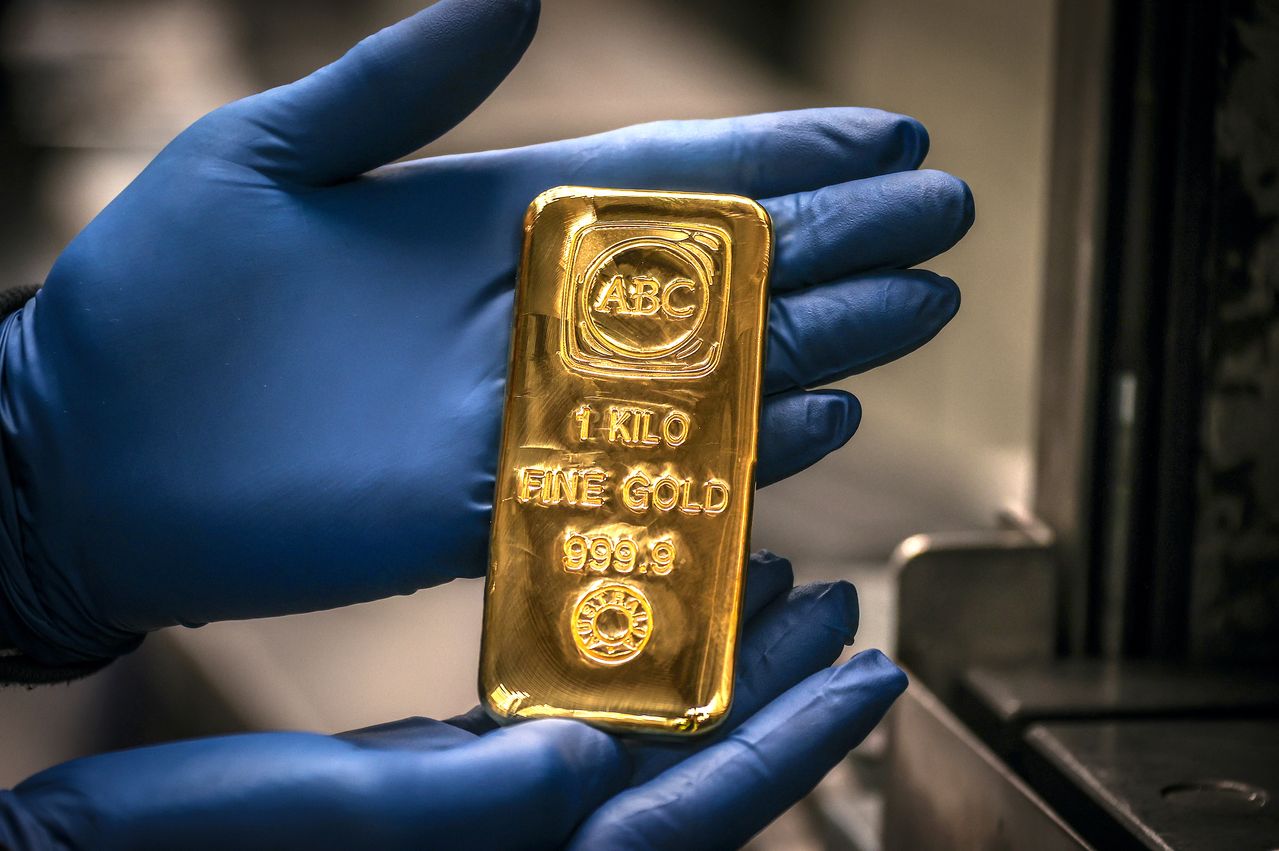Gold has fallen from its lofty August levels. The precious metal appears to be at a crossroads, but the price likely has to slide more from here in order for investors to get really spooked.
The price of gold ran up 37% between March 15, 2020—roughly when investors were most fearful about the economic damage from the Covid 19 pandemic—and August 2, 2020. That day, gold hit an all-time high of US$2,028, as seen by the Gold Continuous Contract (GC00). Even though stocks rose in that time span, demand for haven assets remained strong, as there weren’t many meaningful signs that the world would soon emerge from the pandemic.
Since hitting a record, the commodity has fallen 9% to date. “The long-term uptrend in gold is teetering on the edge,” wrote Jason Goepfert, founder of Sundial Capital Research in a note.
While gold has been in a concerning downtrend of late, gold-related stocks offer some optimism for the precious metal. Gold mining stocks are typically correlated with the actual commodity price. As an example, Goepfert highlights the VanEck Vectors Gold Miners ETF (GDX), which has largely echoed gold’s moves over the past year. The ETF rose more than twofold between mid-March and early August, before falling 20% from the August level to date.
But now gold mining stocks suggest there could be brighter days ahead for the commodity. Roughly 20% of gold mining stocks have been trading above their 200-day moving averages on most days in the past two weeks, down from more than 85% of those stocks recently, Goepfert said. This cycle has occurred several times in the past few years and usually precedes gains for most gold stocks in the coming three-month period, Goepfert says.
Even if gold price trends cannot reverse themselves, it likely isn’t time to get too bearish yet. The key price level to watch for the contract for the actual metal is US$1780, according to Sevens Report Research. A dip below that would be a negative signal, representing a double-digit percentage drop from the current level. Gold dropped to around that level in late November, but quickly popped back.
Gold may be at a fork in the road, but investors might not want to unload their gold holdings just yet.
 Copyright 2020, Dow Jones & Company, Inc. All Rights Reserved Worldwide. LEARN MORE
Copyright 2020, Dow Jones & Company, Inc. All Rights Reserved Worldwide. LEARN MORE
What a quarter-million dollars gets you in the western capital.
Alexandre de Betak and his wife are focusing on their most personal project yet.
To get ahead, learn how to be a connector
Connectors always know just who you should talk to. They send the perfect introductory emails: warm, crisp, direct. And they make it look so effortless.
“It’s almost like music or something,” says David Dewane, a Chicago architect who loves introducing contacts from all parts of his life. “If you do it right, what you get is a little flash of possibility for both people.”
And possibility for the connector, too. Call it karma, the power of networks , or even just luck . If you become that hub for your friends and colleagues, it will come back to you, enriching your circles.
I think of people I know in my own life, the ones I speed text when I need a doctor for my kid. I feel so grateful, like they’re these life buoys that help keep me afloat. I wonder: Can the rest of us do that?
“We all develop a point at which the network that we’re in can’t satisfy our needs anymore,” says Brian Uzzi, a professor at Northwestern’s Kellogg School of Management who studies social network science.
When we become brokers, dipping in and out of various groups, we have access to all kinds of new information: little tips, fresh opportunities. Synthesizing multiple viewpoints, we’re better able to solve problems in innovative ways, Uzzi says. People love us for it.
Getting ahead
Connectors are more likely to get promoted and win bigger bonuses , Uzzi says. In one study of M.B.A. students, those who acted as brokers between cliques were twice as likely to get the best job offers upon graduating, he adds.
The key is to give before you ask.
“The idea of reciprocity is very powerful,” says Greg Pryor, a longtime human-resources executive who now researches organizational psychology topics.
Need a favor while you’re building a relationship, and you’re automatically in debt, he says. Instead, his career has been guided by a pay-it-forward mentality. He ends most calls by asking, “Is there anything I can do to help you?”
One time, a colleague asked if Pryor could get an acquaintance of hers up to speed on the topic of corporate culture and values. He spent a day with the friend-of-a-friend and connected her to others in the industry he thought could help.
The woman ended up becoming the chief human resources officer at software company Workday. When Pryor was looking for his next job, he reached out to her. A few weeks later, he was the new head of talent at Workday.
He spent a decade there, the best stretch of his career, he says.
The email formula
There’s an art to crafting the perfect email intro. Dewane, the Chicago architect who’s orchestrated thousands of introductions, is constantly scanning his mental Rolodex for pairs of contacts who can solve each other’s problems. He usually gets preapproval to reach out from both parties, then turns to his formula.
There’s two paragraphs—one for each person. He describes what they do, why he thought of them, and how they’re perfect to connect on this particular thing. He includes hyperlinks to both LinkedIn profiles. And he always puts the person who stands to gain more from the interaction last, queuing them up to initiate contact.
“I get kind of paranoid if intros just hang there,” he says.
If there’s a big difference in power between the two people, he choreographs the thread even more intricately. When connecting architecture students with professionals he knows at design studios, he’ll inform the students that he’s sending the email at 8 a.m. They are to reply by 8:04 a.m.
“I am going to open the door and then you are going to walk through it,” he says.
Oftentimes people freeze as they sit down to pen an email, scared of overpromising, says Erica Dhawan, a St. Petersburg, Fla.-based leadership consultant and author of a book about digital communication. Sliding into someone’s inbox involves risk. You’re encroaching on their time and looping yourself to two disparate contacts who may or may not hit it off.
Dhawan recommends using the phrase, “no guilt, no obligation,” when asking people if they’re open to connecting.
“I want them to feel like there’s mutual benefit,” she says, not like they’re doing her a favour.
Worst intro ever
Being on the receiving end of an introduction can also leave your stomach in knots, if it’s not done right.
“I’m in an email thread and I’m like, I don’t know why I’m here,” says Khaled Bashir, the founder of a marketing agency and AI startup in Toronto. “What am I supposed to do?”
Fellow founders will often connect him with potential clients. At least he thinks that’s what they are. The context is sometimes missing, and he’d appreciate a funny icebreaker so he can slide into the conversation without it having to be all business.
Bad intros can have happy endings, though.
Years back, Bashir was thrown into a random WhatsApp group by a client. No explanation, just him and one other guy. It turned out the other person was a fellow agency owner. The pair became fast friends. They bonded over the synergies in their work and a love of Japanese comics. Now, Bashir is selling the marketing part of his business to the friend, a move that will let him focus on growing his AI offerings.
Bon appétit
To make connections less awkward, add food. Michael Magdelinskas, who works in government affairs for a consulting firm, hosts frequent dinner parties at his Manhattan apartment. Over sous-vide pork chops and cognac ice cream, he brings together everyone from former colleagues to acquaintances visiting from overseas.
He crafts guest lists by thinking about common hobbies, hometowns and the ratio of introverts to extroverts. Recently, a group of attendees formed their own Instagram chat thread, bonding over an inside joke. They didn’t even think to include Magdelinskas.
“That’s a good thing,” he says. “That means the process is working.”















